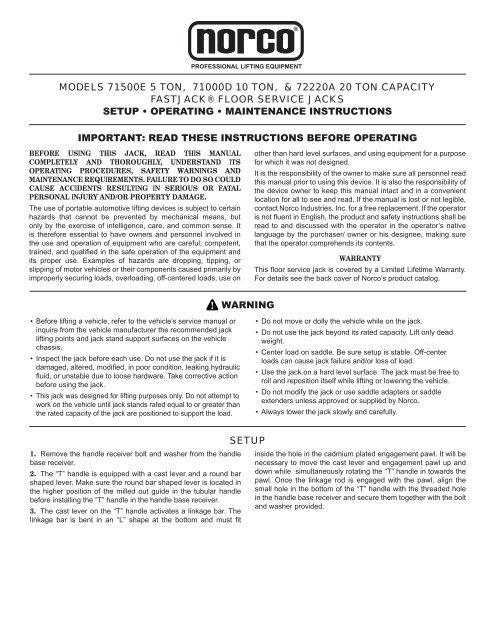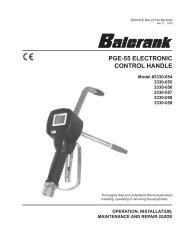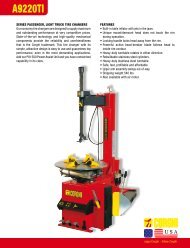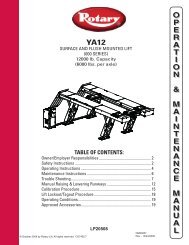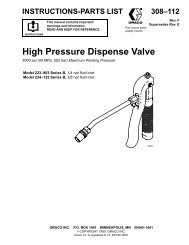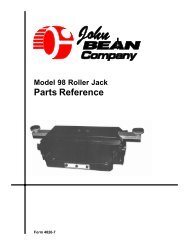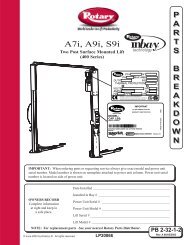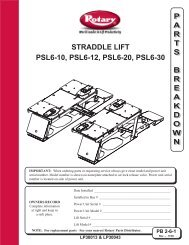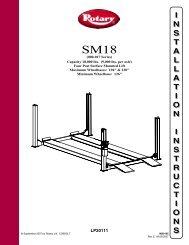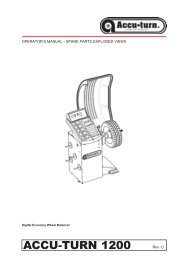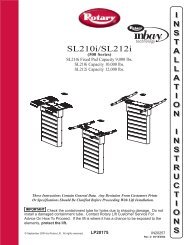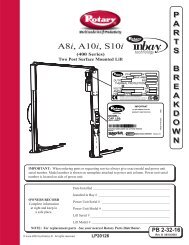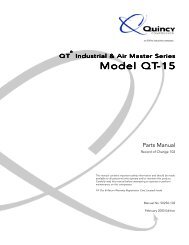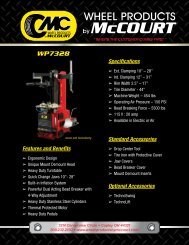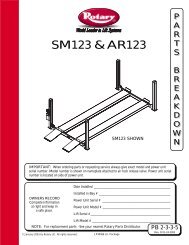models 71500e 5 ton, 71000d 10 ton, & 72220a 20 ton capacity ...
models 71500e 5 ton, 71000d 10 ton, & 72220a 20 ton capacity ...
models 71500e 5 ton, 71000d 10 ton, & 72220a 20 ton capacity ...
Create successful ePaper yourself
Turn your PDF publications into a flip-book with our unique Google optimized e-Paper software.
PROFESSIONAL LIFTING EQUIPMENT<br />
MODELS 71500E 5 TON, 7<strong>10</strong>00D <strong>10</strong> TON, & 722<strong>20</strong>A <strong>20</strong> TON CAPACITY<br />
FASTJACK® FLOOR SERVICE JACKS<br />
SETUP • OPERATING • MAINTENANCE INSTRUCTIONS<br />
IMPORTANT: READ THESE INSTRUCTIONS BEFORE OPERATING<br />
BEFORE USING THIS JACK, READ THIS MANUAL<br />
COMPLETELY AND THOROUGHLY, UNDERSTAND ITS<br />
OPERATING PROCEDURES, SAFETY WARNINGS AND<br />
MAINTENANCE REQUIREMENTS. FAILURE TO DO SO COULD<br />
CAUSE ACCIDENTS RESULTING IN SERIOUS OR FATAL<br />
PERSONAL INJURY AND/OR PROPERTY DAMAGE.<br />
The use of portable automotive lifting devices is subject to certain<br />
hazards that cannot be prevented by mechanical means, but<br />
only by the exercise of intelligence, care, and common sense. It<br />
is therefore essential to have owners and personnel involved in<br />
the use and operation of equipment who are careful, competent,<br />
trained, and qualified in the safe operation of the equipment and<br />
its proper use. Examples of hazards are dropping, tipping, or<br />
slipping of motor vehicles or their components caused primarily by<br />
improperly securing loads, overloading, off-centered loads, use on<br />
• Before lifting a vehicle, refer to the vehicle’s service manual or<br />
inquire from the vehicle manufacturer the recommended jack<br />
lifting points and jack stand support surfaces on the vehicle<br />
chassis.<br />
• Inspect the jack before each use. Do not use the jack if it is<br />
damaged, altered, modified, in poor condition, leaking hydraulic<br />
fluid, or unstable due to loose hardware. Take corrective action<br />
before using the jack.<br />
• This jack was designed for lifting purposes only. Do not attempt to<br />
work on the vehicle until jack stands rated equal to or greater than<br />
the rated <strong>capacity</strong> of the jack are positioned to support the load.<br />
1. Remove the handle receiver bolt and washer from the handle<br />
base receiver.<br />
2. The “T” handle is equipped with a cast lever and a round bar<br />
shaped lever. Make sure the round bar shaped lever is located in<br />
the higher position of the milled out guide in the tubular handle<br />
before installing the “T” handle in the handle base receiver.<br />
3. The cast lever on the “T” handle activates a linkage bar. The<br />
linkage bar is bent in an “L” shape at the bottom and must fit<br />
WARNING<br />
SETUP<br />
®<br />
other than hard level surfaces, and using equipment for a purpose<br />
for which it was not designed.<br />
It is the responsibility of the owner to make sure all personnel read<br />
this manual prior to using this device. It is also the responsibility of<br />
the device owner to keep this manual intact and in a convenient<br />
location for all to see and read. If the manual is lost or not legible,<br />
contact Norco Industries, Inc. for a free replacement. If the operator<br />
is not fluent in English, the product and safety instructions shall be<br />
read to and discussed with the operator in the operator’s native<br />
language by the purchaser/ owner or his designee, making sure<br />
that the operator comprehends its contents.<br />
WARRANTY<br />
This floor service jack is covered by a Limited Lifetime Warranty.<br />
For details see the back cover of Norco’s product catalog.<br />
• Do not move or dolly the vehicle while on the jack.<br />
• Do not use the jack beyond its rated <strong>capacity</strong>. Lift only dead<br />
weight.<br />
• Center load on saddle. Be sure setup is stable. Off-center<br />
loads can cause jack failure and/or loss of load.<br />
• Use the jack on a hard level surface. The jack must be free to<br />
roll and reposition itself while lifting or lowering the vehicle.<br />
• Do not modify the jack or use saddle adapters or saddle<br />
extenders unless approved or supplied by Norco.<br />
• Always lower the jack slowly and carefully.<br />
inside the hole in the cadmium plated engagement pawl. It will be<br />
necessary to move the cast lever and engagement pawl up and<br />
down while simultaneously rotating the “T” handle in towards the<br />
pawl. Once the linkage rod is engaged with the pawl, align the<br />
small hole in the bottom of the “T” handle with the threaded hole<br />
in the handle base receiver and secure them together with the bolt<br />
and washer provided.
1. Become familiar with the levers on the “T” handle. The round<br />
bar shaped lever is spring loaded and follows a milled out guide<br />
in the tubular handle. The lever should be in the higher position of<br />
the milled out guide in order to activate the “quick rise” cast lever<br />
and pump the “T” handle.<br />
2. The “quick rise” lever may be pulled in order to activate the<br />
“quick rise” feature of the FASTJACK. Pulling the cast lever rotates<br />
the cadmium plated engagement pawl so it can come in contact<br />
with the first available lifting tooth. Once the pawl is in position,<br />
pulling down on the “T” handle engages the pawl with the lifting<br />
tooth. Once the tooth is engaged continue to push down on the<br />
handle and you will see the lift saddle raise. Raise the lift saddle<br />
slowly while simultaneously aligning the saddle with the frame<br />
or component to be lifted. Make sure the frame or component is<br />
centered on the lift saddle and not the peripheral edge of the saddle.<br />
If the frame or component is not centered on the saddle, lower the<br />
saddle, reposition the jack and try again. Once the saddle is in<br />
contact with the load, release the cast lever and proceed pumping<br />
the “T” handle until the load is lifted to the desired work height.<br />
3. Lowering the load can only be accomplished by positioning the<br />
“T” handle over one of the three holes in the handle base bracket,<br />
disengaging the round bar shaped lever from its high position and<br />
allowing it to drop to the low position, and rotating the lever to the<br />
right. The load cannot be released unless the lever is rotated to<br />
the right.<br />
4. With the jack in the lowered position, push the jack under the<br />
vehicle. IMPORTANT: Use the manufacturer’s recommended<br />
1. Always store the jack in a well protected area where it will not<br />
be exposed to inclement weather, corrosive vapors, abrasive dust,<br />
or any other harmful elements. The jack must be cleaned of water,<br />
snow, sand, or grit before using.<br />
2. The jack must be lubricated periodically in order to prevent<br />
premature wearing of parts. A general purpose grease must be<br />
applied to caster wheels, front axle wheels, elevator arm, handle<br />
base pivot bolts, release mechanism and all other bearing<br />
surfaces. See the exploded view parts drawing for the location of<br />
the above mentioned parts. Failure to maintain proper lubrication<br />
voids warranty.<br />
3. It should not be necessary to refill or top off the reservoir with<br />
hydraulic fluid unless there is an external leak. An external leak<br />
requires immediate repair which must be performed in a dirtfree<br />
environment by qualified hydraulic repair personnel who are<br />
familiar with this equipment. Norco Authorized Service Centers are<br />
recommended.<br />
If your Norco product requires service or repair, contact the Norco<br />
Customer Service Department for the location of the nearest Norco<br />
Authorized Service Center.<br />
Norco Industries, Inc.<br />
365 West Victoria St.<br />
Comp<strong>ton</strong>, CA 902<strong>20</strong><br />
(3<strong>10</strong>) 639-4000 • Fax: (3<strong>10</strong>) 639-7411<br />
www.norcoindustries.com<br />
OPERATING INSTRUCTIONS<br />
PREVENTATIVE MAINTENANCE<br />
REPAIR SERVICE<br />
lifting procedures and lifting points before lifting loads.<br />
5. Pump the “T” handle or use the “quick rise” feature to get the lift<br />
saddle close to the load. Now raise the lift saddle slowly, making<br />
sure the saddle comes in contact with the load, the load is centered<br />
on the saddle and the majority of the load is not supported by the<br />
peripheral edge of the lifting saddle at any single point.<br />
6. IMPORTANT: Check to see that the ground surface around<br />
the jack is free from wheel obstructions such as gravel, tools,<br />
or uneven joints or edges. The jack will have a tendency to<br />
reposition itself during the lifting process and therefore<br />
should not be hindered by wheel obstructions.<br />
7. Proceed with pumping the “T” handle so the load is lifted to<br />
the required work height. The “quick rise” feature is designed to<br />
eliminate all the incremental pumps required to bring the lifting<br />
saddle in contact with the load. The “quick rise” feature was<br />
not designed to lift the load. Lifting the load is accomplished by<br />
pumping the “T” handle.<br />
8. After lifting the load, always use approved vehicle support<br />
stands with an adequate <strong>capacity</strong> rating to support the load before<br />
making any repairs or adjustments. Position and adjust the stands<br />
under the load at points that will provide stable support. Lower<br />
the load SLOWLY AND CAREFULLY onto the support stands.<br />
Although support stands are individually rated, they are to be used<br />
in a matched pair to support one end of a vehicle only. Stands are<br />
not to be used to simultaneously support both ends or one side of<br />
a vehicle.<br />
IMPORTANT: In order to prevent seal damage and jack<br />
failure, never use alcohol, hydraulic brake fluid, or<br />
transmission oil in the jack.<br />
4. Every jack owner is responsible for keeping the jack label clean<br />
and readable. Use a mild soap solution to wash external surfaces<br />
of the jack but not any moving hydraulic components. Contact<br />
Norco Industries for a replacement label if your jack’s label is not<br />
readable.<br />
5. Inspect the jack before each use. Do not use the jack if any<br />
component is cracked, broken, bent, shows sign of damage, or<br />
leaks hydraulic fluid. Do not use the jack if it has loose or missing<br />
hardware or components, or is modified in any way. Take corrective<br />
action before using the jack again.<br />
6. Do not attempt to make any hydraulic repairs unless you<br />
are a qualified hydraulic repair person that is familiar with this<br />
equipment.<br />
It will be necessary to provide the Norco Authorized Service Center<br />
with a copy of the bill of sale if requesting warranty repair. If the<br />
authorized service center determines your product is eligible for<br />
warranty repair, the repair will be made at no charge and returned<br />
freight prepaid. The cost of non-warrantable service, repair, and<br />
return freight is the customer’s responsibility.<br />
71500E / 7<strong>10</strong>00D / 722<strong>20</strong>A


